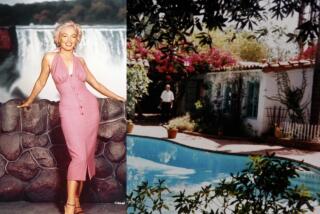Conservationists Accuse State of Ignoring Its Ryegrass Research
Conservationists accuse state forestry officials of ignoring their own research that suggests the ryegrass the state plans to use in reseeding burned areas of the Santa Monica Mountains does little to control erosion and may harm native plants.
Preliminary results of a study suggest that ryegrass seed planted at burn sites in the Santa Monicas and two other mountain areas in Southern California had little impact on erosion, but did retard the growth of indigenous plants, according to a partial summary of the research obtained by The Times. The continuing $300,000 study was funded by the California Department of Forestry and Fire Protection.
Conservationists are using the research as ammunition against plans to use ryegrass in reseeding some areas of the Santa Monicas in Los Angeles and Ventura counties, where more than 50,000 acres were charred by the Thousand Oaks and Calabasas/Malibu fires. Forestry officials say they expect to use some native seed as well.
As part of the continuing multiyear study, researchers at the U. S. Forest Service’s forest fire laboratory in Riverside planted ryegrass seed in three burned areas in 1988 and 1990, including sites in Topanga Canyon in the Santa Monicas, near San Luis Obispo and in the Santa Ana Mountains of Riverside County.
Forest Service plant ecologist Jan L. Beyers said Wednesday that preliminary findings, though incomplete, suggest the ryegrass had no significant effect on erosion but did interfere with the sprouting of native plants.
“We haven’t seen a dramatic effect on erosion,” Beyers said. But the ryegrass did have “a detrimental effect on native plant cover and species diversity.”
Beyers said the findings, however, may not be conclusive enough to trigger a policy shift. “My feeling is, until they have data that’s defensible in court saying (ryegrass) does not reduce erosion . . . they feel they need to seed to protect themselves from liability.”
Scott Franklin, a former Los Angeles County Fire Department captain and vegetation officer, said ryegrass seeding is the wrong approach.
It “is strictly cosmetic and . . . may give people a false sense of security,” he said. “The question that needs to be asked is, ‘Why are you doing this (ryegrass reseeding) when you just paid $300,000 for a study which said it is worthless and may cause long-term degradation?’ ”
But David Neff, regional resource program manager for the state forestry department--which splits reseeding costs with local and federal agencies--said results so far might have been influenced by drought conditions that existed at the time of the reseeding.
Decades of experience with ryegrass have yielded mixed results, he said. “We know at times it worked,” Neff said. “At other times, it didn’t.”
Ryegrass seed has been the traditional fix for scarred lands because it takes root quickly and is abundant and cheap.
It “will provide cover,” acknowledged Rose Rumball-Petre, a naturalist with the National Park Service. “However, if you don’t do anything, you’ll get just as much and maybe more cover from the native seed bank,” she said.
Park officials have long been concerned about the introduction of non-native plants into the Santa Monica Mountains National Recreation Area, a 150,000-acre patchwork of parks and private lands extending from Griffith Park in Los Angeles to Point Mugu State Park in Ventura County.
They say introduced species could eventually change the plant community that nurtures birds and animals native to the mountains.
State and Los Angeles County forestry officials have said they will use native seeds where possible in the Santa Monicas, but that stocks are limited--in part because the highest priority has been given to using native seeds in Laguna--to re-vegetate 10,000 acres of fire-damaged habitat of the threatened California gnatcatcher.
In the Santa Monicas, “we’re not dealing with the focus on endangered species quite like Laguna,” Neff said.
Bowing to concerns of park officials, Neff said no reseeding will be done on state or federal parkland in the western part of the mountains in Ventura County. Ryegrass will be used, however, to reseed about 2,600 acres of non-parkland near Lake Sherwood, he said.
More to Read
Start your day right
Sign up for Essential California for news, features and recommendations from the L.A. Times and beyond in your inbox six days a week.
You may occasionally receive promotional content from the Los Angeles Times.






